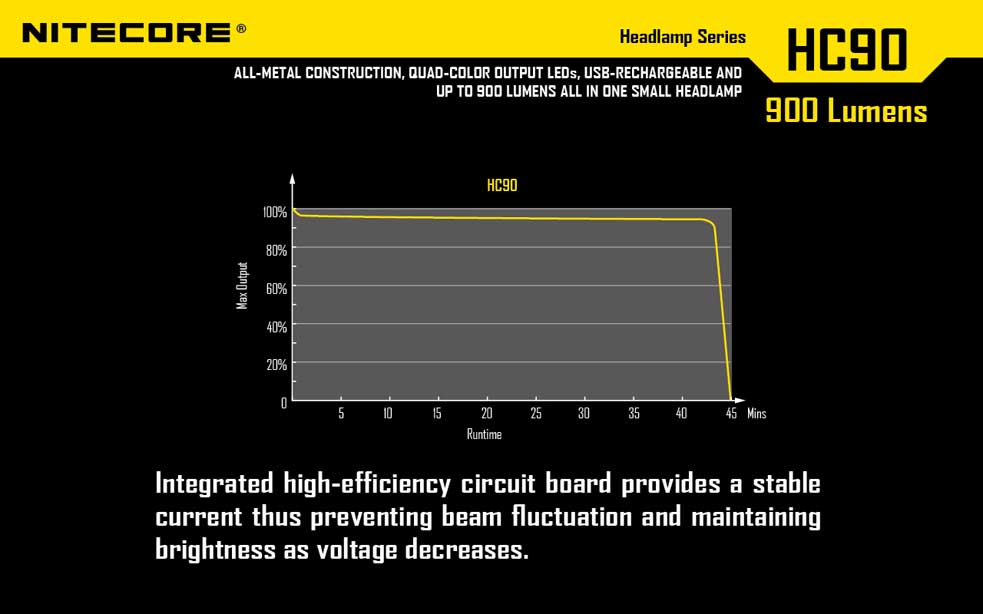
NITECORE HC90
LED: CREE XM-L2 + 3× 5mm Color LEDs
Battery: 1× 18650 / 2x (R)CR123a
Modes: Variable magnetic control.
Switch: Electronic (Magnetic Slider)
Date: April 2014
INTRODUCTION:
Following the launch of the first dedicated headlamp few months ago by the Nitecore brand, just arrived the second raid by the famous Chinese manufacturer in the headlamps range. The Nitecore HC90 is similar in design to the HC50, but incorporates some new interesting features, such the magnetic control and the ability to stepless adjust the light output. Another interesting function implemented in this new proposal by Nitecore is embedded battery charging through standard microUSB port, as well as incorporating RGB multicolor light through three small LEDs of 5mm and a maximum output much higher than the previous base model HC50.

The product packaging is very similar to what we saw in the HC50 , and common in design and presentation to the recent launches of the brand. The Nitecore HC90 comes in a compact cardboard box printed in full color with the usual colors of the brand, including a brief description of the product and some of its specifications.
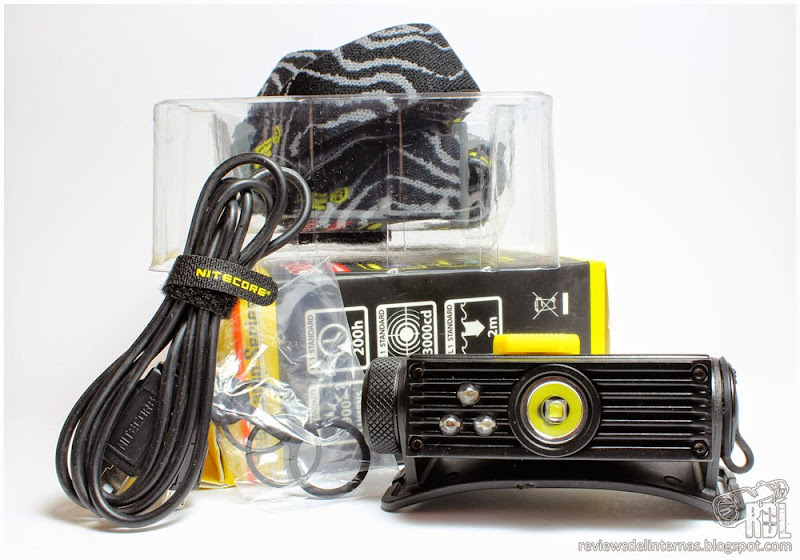
Inside the headlamp unit is accompanied by a similar to HC50 the elastic bands, a set of replacement o-rings, USB-to-MicroUSB cord and including extra dust-cover-plug for charging port, and the usual documentation with an user manual in English and SYSMAX warranty card.
EXTERIOR FINISH:
Construction of HC90 headlamp is quite broadly similar to that we saw with the HC50 , with identical optics characteristics in the center of a large passive heatsink integrated into the front of the headlamp featuring a mono-block design.

On one side of the optics, we find the three small RGB LEDs in charge of the color lighting. Unlike SRT series, rather than using 5mm RGB LEDs , this time each of the three small LEDs emit only one color, largely avoiding the typical aberrations caused by the eccentric position of each die within encapsulated.


White light is provided by XM-L2 T6 CW located behind a small, very shallow smooth reflector, which is hold in place by a flat bezel and AR coated glass.

At the top of the unit we find a sliding part made of yellow plastic. Through this piece we can select the mode, sliding to the right for different colors, or left to adjust the brightness of the XM-L2.
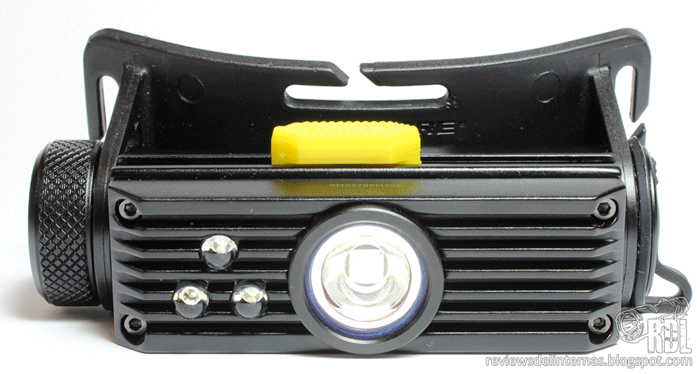
The slider runs smooth and has several detents in strategic position. The track comes generously lubed from factory, and is extremely comfortable to adjustment with one hand, easily detecting the various detents (more details in the user interface section below).

At one end of the headlamp there is a cap whereby we access the interior of the battery compartment. This cap has square cut and anodized threads. The negative contact is made by a gold platted spring located in the cap, while the positive is at the bottom of the housing for the battery and has a mechanical protection against reverse polarity.

Although I have not had problems using flat top batteries like NCR18650A , the reverse polarity protection system makes using button top batteries recommended. There is enough to room for accommodate protected batteries up ~ 71mm long.

At the opposite extreme is another of the most interesting developments implemented in the HC90, an integrated charging port with microUSB connector. The port is protected by a silicone dust cover, and features a translucent lining allowing you to see the light of the charging status indicator small red LED.


The elastic bands are very similar in length and quality to the HC50 , with a generous section and very good elastic properties, so the weight of the headlamp when installed in our head and adjusted the bands is well distributed. Unlike the HC50, the front unit clamping is made by a part of semi- rigid plastic which is installed directly on the headlamp , and which has a curvature designed to successful engage our forehead comfortably .

The elastic band is between this piece and our forehead skin, avoiding friction with the semi – rigid plastic support and ensuring optimal support and nice comfort.
USER INTERFACE:
The Nitecore HC90 has a simple user interface , wherein the magnetic slider takes all the merit. In addition to the three modes of light color, we have stepless brightness adjustment for the XM -L2 allowing us to fine adjustment the light output between 0.2 and 530LM. There is an extra position on the left end of the slider rail, with a detent, reserved for the Turbo mode.
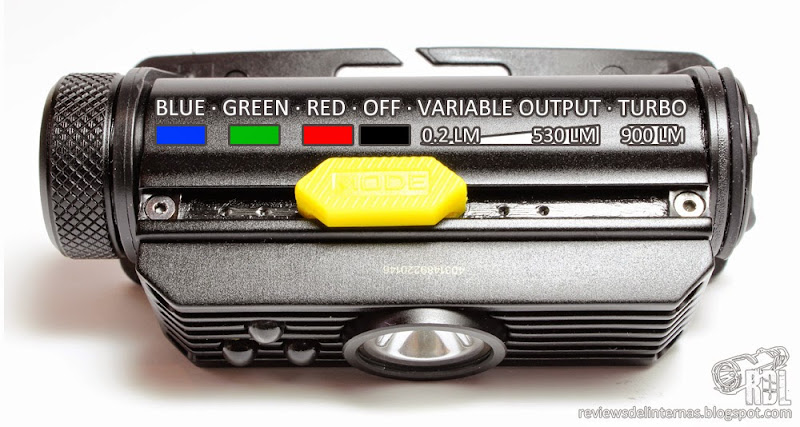
- Standby / OFF position: Right between the red LED detent and the beginning of the variable slider, there is a position in which the headlamp is off/standby.
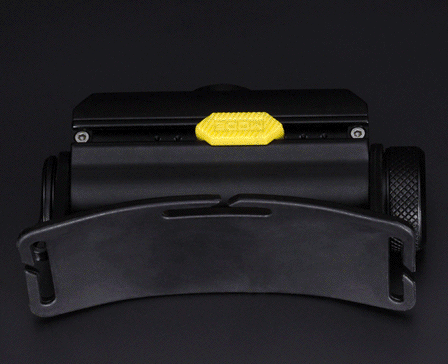
- Variable white light mode: Moving the slider to the left, we enter the variable output mode setting for white light. We can select the output that suits us better for any situation, within the range between 0.2 and 530LM, point at which the slider has a detent. There is approximately 25mm of travel, so finding the right output is easily archived.
- Turbo Mode: Located at the left end of variable adjustment, we have an extra position beyond the detent for the High mode, in which the headlamp enters turbo mode, with 900 Lumen. This mode is located at the top left end of the slider, so it is easy and fast to access it from any position.
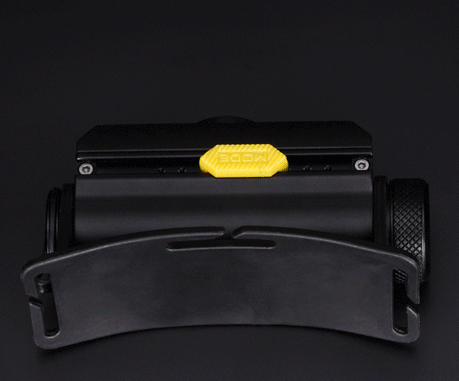
- Auxiliary light color modes: From the standby position, moving the slider to the right are three detents, each corresponding to an auxiliary color LED. The first detent is the red, then the green and the next on the right end of the slider gives access to blue light.

- Mechanical block-out: The headlamp can be blocked by the thread to avoid parasitic consumption that is always present in this type of tools that lack a mechanical switch. After checking with a fully charged battery I get a measurement of between about 8 mA for the first 30 seconds after a sudden drop to ~0.18mA . Nitecore mention in the user manual refers to this block-out, recommending it if we are not using the headlamp over a long period of time, also indicating that the current needed to maintain alive the HC90 interface should take 6000 hours (about 250 days) to completely drain an 18650. This obviously also prevent accidental activation of the headlamp when we carry it in a backpack or pocket.
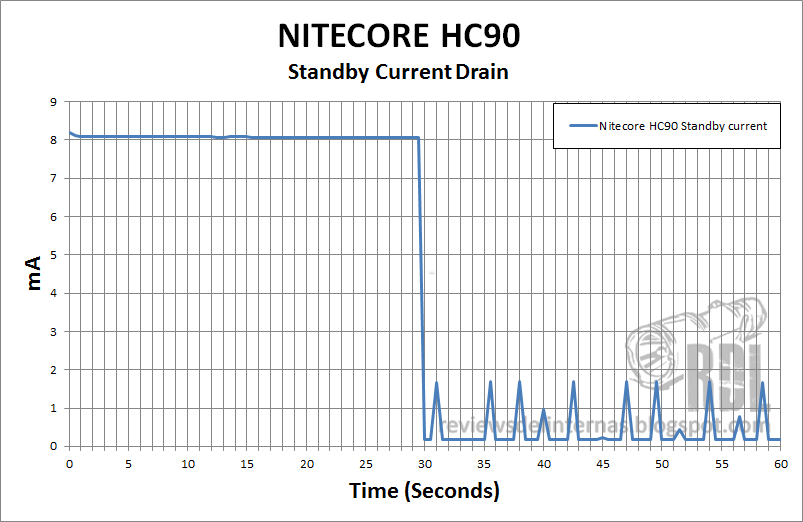
- Integrated charger: The HC90 features an integrated charger, allowing us to recharge the 18650 battery installed without removing it. This charging system is powered by a microUSB port and can be connected to any USB common power supply, such as a wall charger for Smartphone or Tablet , a USB port of a PC, a powerbank … The charge current is limited to 500mA ( 515mA according to my multimeter) regardless of input system specifications we use, so fully charge a 3100mA 18650 battery will takes more than 6 hours. The final charge voltage to the battery is 4.2V, and shows a correct CC/CV algorithm , gradually decreasing current when charging reaches ~4V, to finish charge properly. The charging port is equipped with a red LED that will inform us of the state of charge through various sequences: One blink approximately every 2 seconds denotes a charge in process, rapid blinking a problem with the battery (charge stopped) and if the light remains steady on indicates that charging is complete.
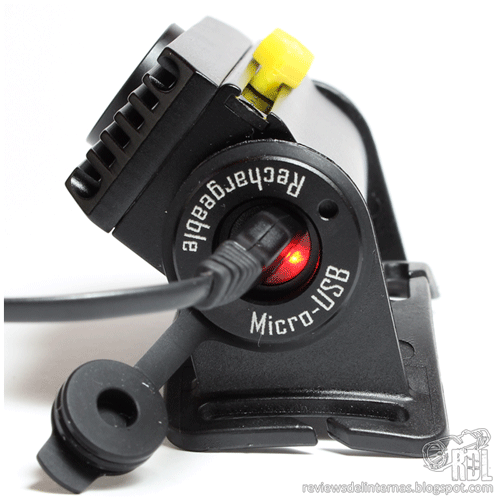
NOTE: Although the HC90 can be powered by one 18650 battery, two primary CR123a or two rechargeable RCR/16340 , the system only supports charging 18650 battery.
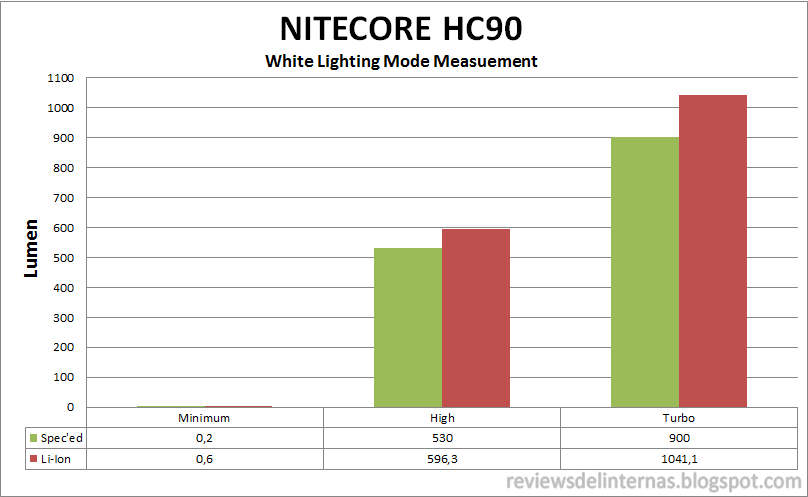
(All measurements are taken following the ANSI NEMA / FL1 procedure using a peak measurement between 30 and 120 seconds after activation. More details in my ForoLinternas thread.)
As happened with the HC50 , measured in integrating sphere performance is somewhat above that specified by the manufacturer, reaching a staggering 1040LM after 30 seconds of constant power at its Turbo mode, and close to 600LM for High mode.
PERFORMANCE:
The HC90 inherited basic version HC50 temperature control, which replaces the usual time controlled stepdowns (typically 3 minutes), and offers a more dynamic performance depending on the environment in which we use the headlamp. Thus, the thermal sensor inside the guts of the HC90 makes this reduces its light output when it reaches a temperature above 55 ° celsius.
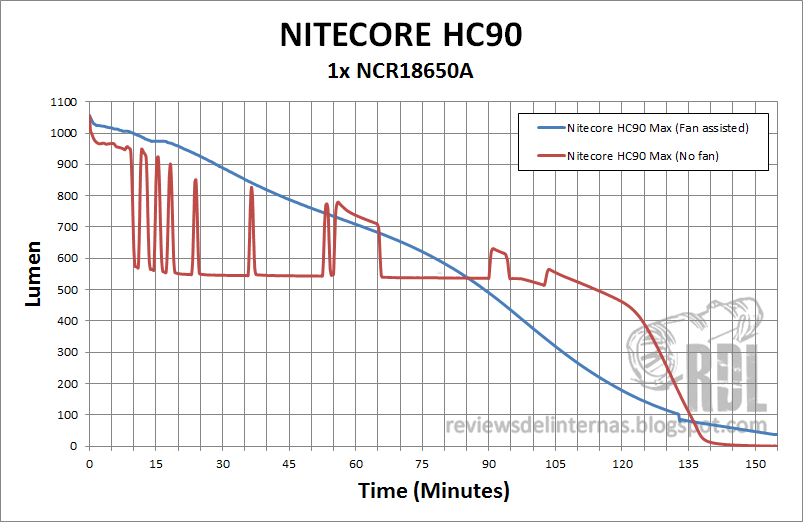
In the graph we can see two separate tests, one with the headlamp at room temperature and another in which I've have helped with a small fan to keep the temperature down. You can clearly see as at room temperature and without the fan, at about 10 minutes of continuous use the headlamp exceeded 55 degrees Celsius and lowered its output from Turbo to High mode, where thanks to the lower current has been capable of lowering the temperature again and Turbo mode automatically entered into action. These ups and downs are performed gradually (making a sort of fade in and fade out) and are hard to notice by the naked eye.
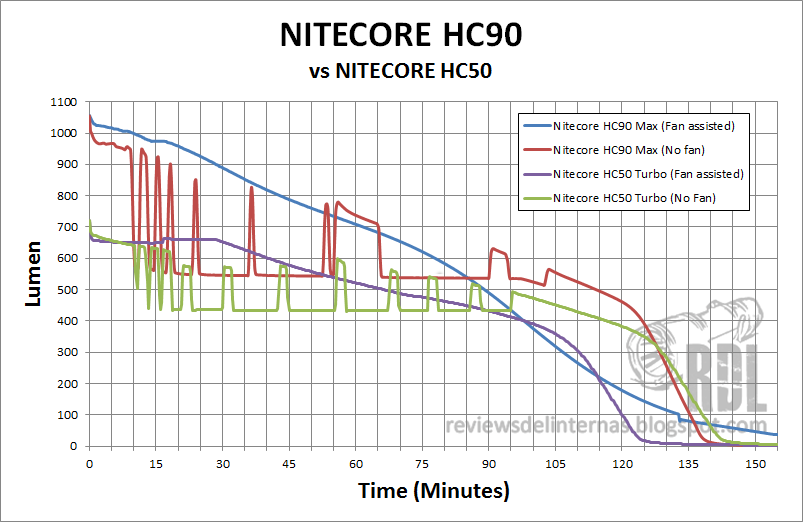
Compared with the performance of HC50 , this new HC90 shows step forward in efficiency , obtaining a very similar type of runtime thanks to the nonlinear regulation which Nitecore has provided in its configuration for a 18650.
BEAM PROFILE:
The beam profile of the HC90 is almost identical to that already seen in the HC50 , at 100 º angle of light output, with a huge hotspot and a generous peripheral light , covering a wide illuminated area . Thanks to the extra output, the throw is now 110m and 3.000cd (NEMA ANSI FL1), 25 extra meters than the HC50.
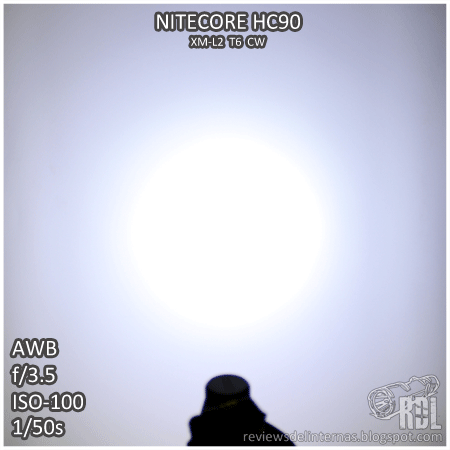
The XM-L2 T6 tint is cold, with a familiar yellowish hue in the gradient between the hotspot and spill.
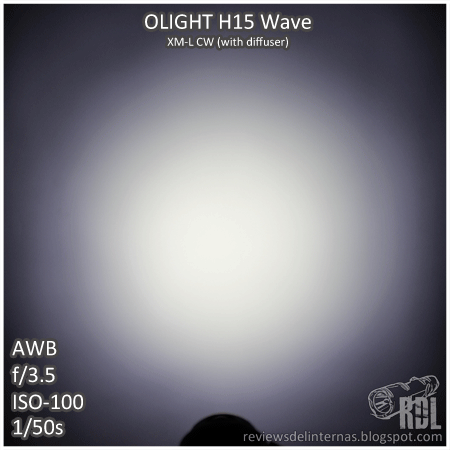
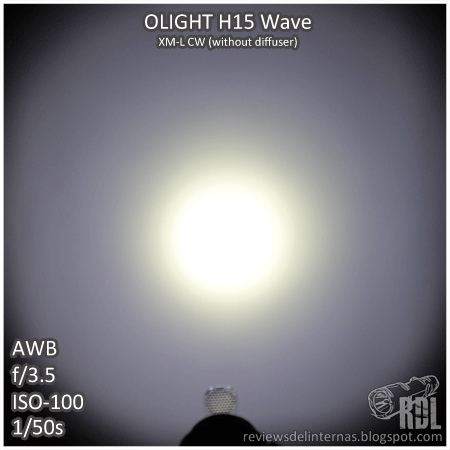
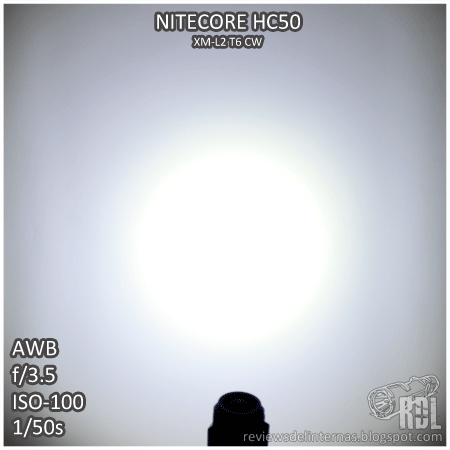
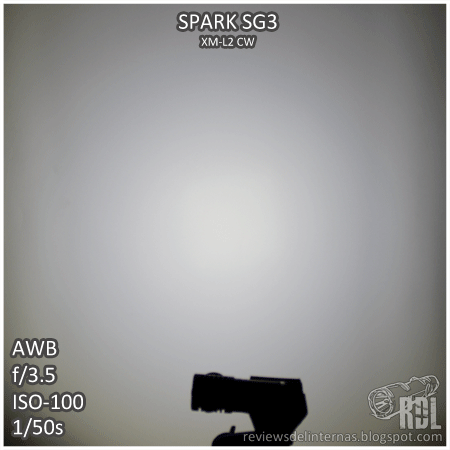
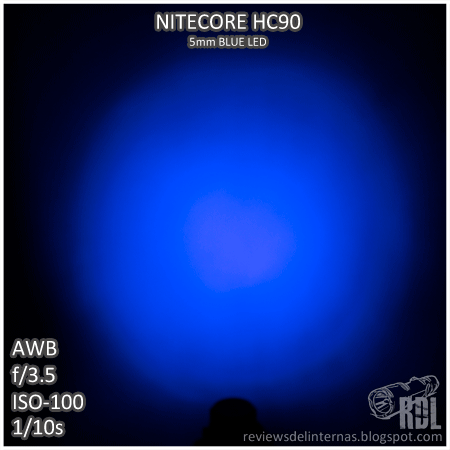
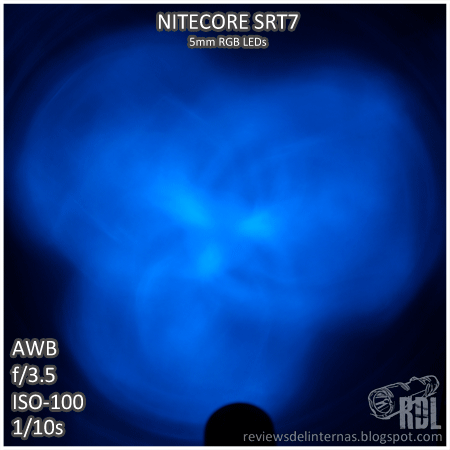
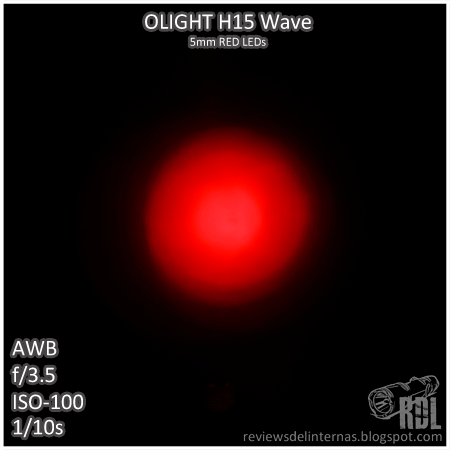
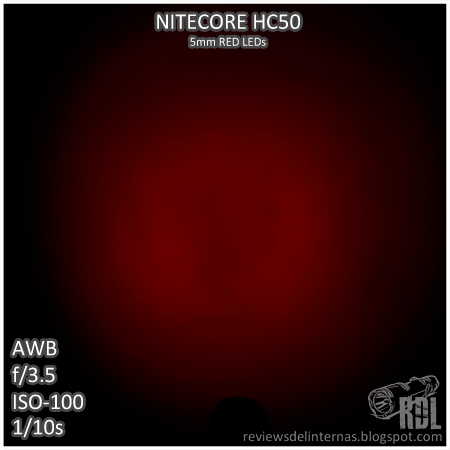
The auxiliary color lighting has surprised me with homogeneous beam, as Nitecore has chosen to use each of the three 5mm LEDs for a specific color, instead of usingRGB LEDs (able to offer three colors in a single package) such as used in SRT range. Having single DIE, small 5mm LEDs offer a pretty good projection and almost free of any ring or artifact.
PERSONAL CONCLUSION:
Broadly speaking, the HC90 comes to offer a more complete alternative to what its basic version, the HC50 offers some spot functional improvements and robust and easy to use design.

Negatives: In the now common trend in the use of colored light , the HC90 offers a much better performance than seen in other same brand flashlights, such as SRTs, but still a step behind in efficiency and performance than theoretically could be achieved with CREE RGBW powerLED. I wonder what would have been the result would have become if instead of using the three 5mm color LEDs, they installed instead a XM-L Color behind a small aspherical lens, offering the same range of color, but incorporating the CREE power and efficiency, way above the unfortunately usual 5mm LEDs.
Positives: I especially liked how easy and intuitive it is to take control of the headlamp, thanks to the well-designed slider system. As in the HC50, simple and robust design is one of its virtues, and the successful combination of hybrid beam profile, capable of offering a floody projection but without giving up a decent range due to huge hotspot. Temperature control rather than time is something we are all looking forward to evolve and be incorporated into other models of the brand, thus avoiding those unnecessary stepdowns when the actual temperature of the unit can hold it. Efficiency seems to be one step ahead of the previous version, sacrificing the linearity of its output (in its version for 18650) for excellent runtime. The 5mm LEDs beam is, fortunately, not as bad as expected, having seen how it performs in the SRT range. The USB compatible charging port is a great improvement that allows us to maintain our headlamp always charged and ready by using our Smartphone or tablet charger adaptor, without carrying a dedicated charger or extra batteries. The design of the elastic bands makes the weight distribution very nice, forgetting in a few seconds you have it installed on your head. In short, if the budget allows, the HC90 is a recommended option that for sure will please all who try.
Nitecore HC90 headlamp provided by Nitecore.co.uk for review. Thanks!
Last edited:



